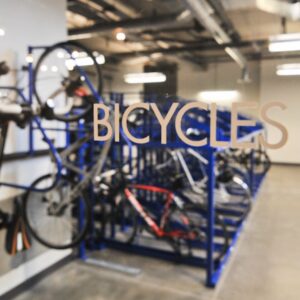“I’d like to think through a little further of what the impact would be.”
— John Carroll, real estate developer with Carroll Investments
On Wednesday, I published an article that incorrectly stated that the Portland Planning Commission had voted to approve a zoning code change that would make a major increase to the minimum number of bike parking spaces required in multi-family dwellings (condominiums and apartments).
In fact, the Commission did not pass the bike parking code change (which is a part of a larger package of code changes) and instead has decided to take up the issue again on October 27th.
The City of Portland is proposing an increase to the minimum requirement of bike spaces from the current 1 space per 4 units to 1.5 spaces for each unit. Several people, including Michelle Poyourow of the Bicycle Transportation Alliance (BTA) and Portland developer John Carroll, testified in support of the increase at Wednesday’s hearing.
The code change had smooth sailing at the hearing and word spread throughout PBOT (and to me) that the Planning Commission had passed it (remember, from there it would still need to be passed by City Council).
However, late in the hearing and after his initial testimony, Carroll listened to Bureau of Transportation bike coordinator Roger Geller explain their methodology for coming up with the 1.5 per unit number. After hearing that, Carroll stepped back up to the mic and expressed concerns. I reached Carroll this morning to ask him why he wants to take a few more weeks to think about the code change.
It turns out that Carroll is concerned about his reputation in the development community if he’s the one pushing for such a substantial increase in bike parking space requirements. “I’m in support of increasing bike parking, but I was confused by the formula he [Geller] used. The biggest concern is that it comes up and the development community says ‘that’s a crazy number’.”
So how did PBOT come up with the 1.5 per unit proposal? Bike parking program manager Sarah Figliozzi explained that PBOT surveys show 70% of Portlanders own at least one bicycle. She then analyzed U.S. Census numbers and found that the average amount of residents in a multi-family dwelling is 1.64. Multiply 1.64 by the number of people who own a bicycle (.7), and you get 1.15.
[Figliozzi also pointed out that PBOT proposed 1 space per unit way back in 1996, a decision based on work of a task force that met for nine months (that proposal was nixed by developers in favor of 1 space for every 4 units).]
To get from 1.15 to 1.5, Figliozzi says considering the lifespan of buildings in Portland and that, given the City’s Climate Change goals and commitment to promote bike use (Portland Bike Plan calls for 25% of all trips by 2030), an increase to 1.5 is warranted.
To put the number in perspective, Figliozzi said it’s only 4 bike storage spaces for every 3 people who own a bicycle.
Carroll is very open to the new requirement, but he just wants to make sure the increase would be feasible for developers. “I’d like to think through a little further of what the impact would be.” He plans to walk through several of his buildings with the BTA’s Poyourow in the next few weeks to find out how much of an imposition it would be for developers to reach the proposed 1.5 spaces per unit.
Carroll also mentioned that perhaps the new requirements should not apply in all locations. “If you had a development on Skyline [a road in the hills high above downtown Portland], would it really make sense to have that much bike parking when you’d probably only have about three people who would ride up there?”
Just what type of impact would the proposed code change have on a building? Take Carroll’s The Eliot as an example. It’s got 228 units. Multiply that by 1.5 and you get 334. Even for a developer like Carroll, who understands the need to accomodate bicycles, 334 bike parking spaces is a lot.
Carroll plans on testifying again on October 27th after he’s had more time to think about the proposal. “Rather than have it be a no-brainer conversation, I’d like to have some data in front of me. This is a really important conversation.”
Planning Commission will take up this issue at their meeting on October 27th. Stay tuned.






Thanks for reading.
BikePortland has served this community with independent community journalism since 2005. We rely on subscriptions from readers like you to survive. Your financial support is vital in keeping this valuable resource alive and well.
Please subscribe today to strengthen and expand our work.
I would require one bicycle space per unit OR one bicycle space per car space; whichever is larger.
And I wouldn’t exempt any areas. Saying we shouldn’t put bike parking in the homes because people in that area don’t ride is backward. We should say that because people in the area don’t ride we want to make it even more attractive…
How many car spaces does the 228 unit Elliot have? 334 bike spaces would take up about 50 car spaces, and the bike spaces can be put just about anywhere and don’t need any major structural engineering beyond walls or a cage… (unlike car spaces which require huge garages and all sorts of planning for ingress/egress and loading and height and size and all of that junk).
The Skyline argument doesn’t work.
Those people statistically still own bikes and need a place to keep them.
If developers are afraid of taking space away from car parking then hallways need to be large enough to pass a wheelchair and bike simultaneously. Each unit needs a bike closet of proper size with a light and I think a floor drain would be nice.
A convenient facility to wash muddy and snowy bikes off before taking them inside seems logical if you cannot keep them outside or in a parking facility.
I live in a condo in the pearl with 2 levels of car parking in our building, and the usual 1 bike spot for every 4 units fixtures.
There is sadly no way near enough bike parking for the number of bikes we have in the building, so as a result bikes are tied up to any available fixed structure in the carpark area, outside, and on top of each other. There’s contention of the few “real” bike parking facilities.
Meanwhile, my car spot goes unused — and I can’t tie my bike up there.
Don:
Would you be allowed to anchor a few bike staples to the concrete in your car space? Then you could rent out bike parking at a few bucks a month. People “sublease” their parking spaces all the time — why not repurpose them as well?
I would require one bicycle space per unit OR one bicycle space per car space; whichever is larger.
PBOT’s math is a little bit complicated. Another way to think about it is that 1.5 spaces/unit gets you very close (~90%) to one bike parking space for every resident.
Given current trends in ridership and the aspirations of the bicycle master plan, is it unreasonable to think that within the lifetime of buildings being built today (20+ years) that 90% of Portlanders would own a bicycle (particularly those Portlanders living in neighborhoods dense enough to sport multi-family buildings)?
Ok so car parking bad, bike parking good. What about car spaces with retractable bike staples or rack. Ceiling drop enclosures. A hose reel for cleaning off the major stuff on that bike.Come on there must be designers out there looking at this site. What do you say.
Idea: Allow bike-owners with no cars to install a staple in their reserved parking space. I wonder what the results would be (and this one would work retro-active to all the buildings that got around the last round of changes).
The big fear in the eyes of developers is not that bike parking takes away from car parking, it is that bike parking is an additional requirement. A single parking spot in a parking garage can cost 35-40K to construct. If you can get 8 bike parking spaces per car space, would you pay $5000-$7000 for a space to park your bike?
Parking is typically one of the hardest parts of a building to sell, whether it is for cars or bikes. Developers want to sell every inch of the building.
Adding staples to parking garages would be challenging, because most parking structures are made from post tensioned concrete. Fasteners are typically only allowed 3/4″ of bite into the concrete to avoid damaging the structure. However, anchoring some other type of bike rack to the wall would likely be feasible.
The big fear in the eyes of developers is not that bike parking takes away from car parking, it is that bike parking is an additional requirement.
I think that’s exactly right. From a sustainability point of view, I would hate to think that bike parking was going to make buildings bigger.
Ideally this would be accomplished either by reallocating space used by auto parking (tricky, developers can sell auto parking spaces, they probably can’t sell a bike parking space on an ala carte basis, it’s just likely to get added to the cost of a unit) or by finding ways to add bike parking without additional square footage (hooks, other approaches mentioned above).
Mike M:
Interesting points. However, I bet the true cost of bike parking is substantially cheaper than 1/8 of a car spot, because a car spot has certain ingress/egress requirements that a bike does not have. If bike parking were designed from the beginning, instead of retrofit into an already designed garage area, the costs would surely go down. In theory, you’d think that additional bike capacity could offset the need for some car spaces, so the builder would be financially rewarded by being bike-friendly.
Every time I drive (a car) up Skyline I pass cyclists. I’m willing to bet some of them live up there.
How many of them live in the multi-family buildings (condos, apartments) this code would apply to?
If it can be structured so that developers are INCENTED to swap car parking for bike parking, then we’d get somewhere. Let them SAVE MONEY by ADDING Bike parking. They would create whole buildings targetted at bikes/peds. Seriously. There is definitely room in this market for an apartment or reasonably priced accomodations that is 100% bike oriented. The city needs to encourage that, perhaps in specific zones. There is all this ‘transit oriented development’, why not create a cluster of higher density. Heck, increase the FAR (floor area ratio) so they can have a bigger building footprint, vacate the streets between several buildings and just have bike/ped paths, etc. Go further with the thinking and build things around the bike, not the car.
Personally I wouldn’t care how much bike parking an apartment complex had, I would still bring my bike inside, where it is much less likely to be stolen or vandalized.
bike parking can take several forms. Would a couple of hooks in a basement storage unit meet code? Would it need to be outside storage, ala staple racks? A room inside,lockable? What would the requirements mean to a developer? Are they clear and enforceable?
I don’t think Mr Carrol is displaying anything other than caution in his reservations. Most developers know ‘green and sustainable’ also means more marketable development. But nobody wants to be saddled with requirements that don’t make sense or provide any benefit. There is still sufficient time to work through this.